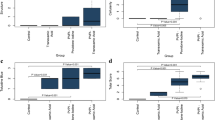Summary
A 33-year-old female dialysis patient suffered from osteomyelitis and luxation of the dens axis with cervical myelopathy. In the past she had had three attacks of anaphylaxis after treatment with dialyzers that had been sterilized with ethylene oxide. IgE-type antibodies directed against human serum albumin-ethylene oxide complexes could be demonstrated in the patient's serum by radioallergosorbent techniques. Immediately after an operation in which acrylic bone cement (Palacos-R) sterilized with ethylene oxide was implanted for stabilization of the cervical spine, the patient developed massive edema of the larynx, pharynx, and tongue, suggesting Quincke's edema. It is concluded that ethylene oxide present in acrylic bone cement may induce acute allergic reactions in sensitized patients. Dialysis patients may be at special risk, since the incidence of ethylene oxide allergy in this patient population is about 10%.
Zusammenfassung
Eine 33jährige Dialysepatientin litt an einer Osteomyelitis und einer cervikalen Myelopathie bei Luxation des Dens axis. Bei der Patientin war in der Vergangenheit dreimal ein anaphylaktischer Schock aufgetreten, nach Behandlung mit Dialysatoren, die mit Ethylenoxid sterilisiert worden waren. Eine Ethylenoxid-Allergie mit Nachweis von IgE-Antikörpern gegen Komplexe aus Humanalbumin und Ethylenoxid konnte mit der Radioallergosorbent-Technik (RAST) gesichert werden. Unmittelbar im Anschluß an eine operative Stabilisierung der Halswirbelsäule mit Knochenzement (Palacos R) kam es zu einem Quincke-Ödem mit massiven Schwellungen des Larynx, Pharynx und der Zunge. Palacos wird mit Ethylenoxid sterilisiert. Wir schließen daraus, daß restliches Ethylenoxid im Knochenzement bei sensibilisierten Patienten zu akuten allergischen Reaktionen führen kann. Dialysepatienten sind als besondere Risikogruppe für solche anaphylaktischen Reaktionen anzusehen, da die Inzidenz einer Ethylenoxid-Allergie in dieser Patientengruppe bei etwa 10% liegt.
Similar content being viewed by others
References
Henne W, Dietrich W, Pelger W, von Sengbusch G (1984) Residual ethylene oxide in hollow-fiber dialyzers. Artif Organs 8:306–309
Nicholls AJ, Platts MM (1984) Anaphylactoid reactions during haemodialysis are due to ethylene oxide hypersensitivity. Proc Eur Dial Transplant Assoc 21:173–176
Poothullil J, Shimizu A, Day RP, Dolovich J (1975) Anaphylaxis from the product(s) of ethylene oxide gas. Ann Intern Med 82:58–60
Rumpf KW, Seubert S, Seubert A, Lowitz HD, Valentin R, Rippe H, Ippen H, Scheler F (1985) Hypersensitivität bei Dialysepatienten. Häufigkeit von Eosinophilie, IgE-Erhöhung und Ethylenoxid-induzierten Antikörpern. Dtsch Med Wochenschr 110:1641–1645
Rumpf KW, Seubert S, Seubert A, Lowitz HD, Valentin R, Rippe H, Ippen H, Scheler F (1985) Association of ethylene oxide-induced IgE antibodies with clinical symptoms in dialysis patients. Lancet 2:1685–1687
Author information
Authors and Affiliations
Rights and permissions
About this article
Cite this article
Rumpf, K.W., Rieger, J., Jansen, J. et al. Quincke's edema in a dialysis patient after administration of acrylic bone cement: Possible role of ethylene oxide allergy. Arch. Orth. Traum. Surg. 105, 250–252 (1986). https://doi.org/10.1007/BF00435492
Received:
Issue Date:
DOI: https://doi.org/10.1007/BF00435492




